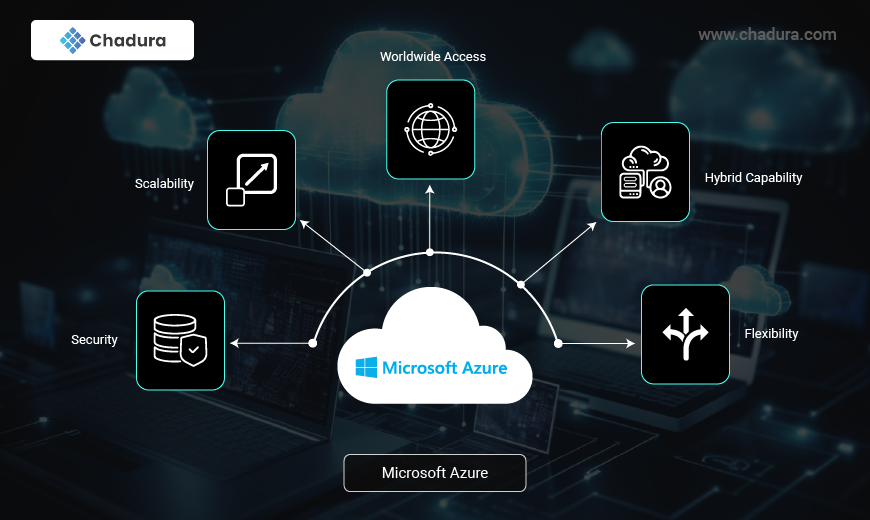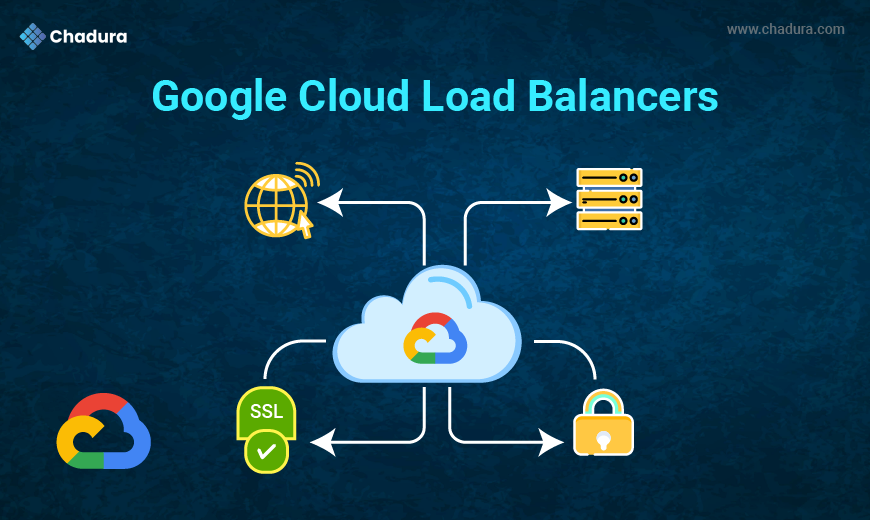What are the various Azure Services and How does Azure Work?
Following are some of the services Microsoft Azure offers:
- Compute: Includes Virtual Machines, Virtual Machine Scale Sets, Functions for serverless computing, Batch for containerized batch workloads, Service Fabric for microservices and container orchestration, and Cloud Services for building cloud-based apps and APIs.
- Networking: With Azure, you can use a variety of networking tools, like the Virtual Network, which can connect to on-premise data centers; Load Balancer; Application Gateway; VPN Gateway; Azure DNS for domain hosting, Content Delivery Network, Traffic Manager, ExpressRoute dedicated private network fiber connections; and Network Watcher monitoring and diagnostics
- Storage: Includes Blob, Queue, File, and Disk Storage, as well as a Data Lake Store, Backup, and Site Recovery, among others.
- Web + Mobile: Creating Web + Mobile applications is very easy as it includes several services for building and deploying applications.
- Containers: Azure has a property that includes Container Service, which supports Kubernetes, DC/OS or Docker Swarm, and Container Registry, as well as tools for microservices.
- Databases: Azure also included several SQL-based databases and related tools.
- Data + Analytics: Azure has some big data tools like HDInsight for Hadoop Spark, R Server, HBase, and Storm clusters
- AI + Cognitive Services: Azure developing applications with artificial intelligence capabilities, like the Computer Vision API, Face API, Bing Web Search, Video Indexer, and Language Understanding intelligence.
- Internet of Things: Includes IoT Hub and IoT Edge services that can be combined with a variety of machine learning, analytics, and communications services.
- Security + Identity: Includes Security Center, Azure Active Directory, Key Vault, and Multi-Factor Authentication Services.
- Developer Tools: Includes cloud development services like Visual Studio Team Services, Azure DevTest Labs, HockeyApp mobile app deployment and monitoring, Xamarin cross-platform mobile development, and more.
What is Azure Security Center?
Azure Security Center is a comprehensive security management platform provided by Microsoft for Azure users. It offers several key benefits, including:
- Visibility and Control: It enables users to gain insight and manage the security of various Azure resources, such as Virtual Machines, Cloud Services, Azure Virtual Networks, and Blob Storage.
- Protection for Hybrid Workloads: It secures workloads that are deployed both within Azure and in non-Azure environments, including on-premises systems.
- Enhanced Security Posture: The Azure Security Center continuously monitors the cloud environment, helping users understand the security status of their resources and improve their security posture.
- Threat Detection and Mitigation: With a centralized dashboard, the Azure Security Center provides alerts and recommendations, assisting organizations in detecting and preventing cybersecurity threats. This also aids in regulatory compliance by streamlining security policies across the platform.
Additionally, Azure Security Center tackles several security challenges:
- Dynamic Workloads: As customers utilize a variety of cloud services that frequently change, the Azure Security Center simplifies the implementation of security standards and best practices.
- Evolving Threats: With more organizations shifting to the public cloud, cyber threats have become increasingly sophisticated. Azure Security Center helps customers secure their workloads and minimizes vulnerabilities by promoting adherence to security best practices.
- Lack of Security Expertise: The high volume of security alerts can overwhelm administrators, especially those with limited experience. Azure Security Center equips administrators with tools to effectively respond to and manage these threats.
What is Microsoft Azure Architecture?
Microsoft Azure, a well-known cloud computing platform, provides users with the tools to design, deploy, and manage numerous applications and services. Various products include machine learning, mobile application development, and Internet of Things (IoT) solutions, making it vulnerable for almost all application or service types. The Azure platform can work from PCs, laptops, smartphones, and tablets, and supports many programming languages, including HTML5, JavaScript, PHP, Python, and C#.
Along with application hosting, Microsoft Azure is also a safe place to store information where users can store files online and access them from anywhere. Commonly used to host applications including email and social media, it can store any kind of data from documents to images to videos.
Microsoft also operates many physical data centers globally. IT infrastructure, such as server racks and network connectivity, is necessary for enterprises and organizations to run their IT requirements. The key technique in this infrastructure is virtualization, which reduces excess physical hardware by dynamically scaling the resources required, depending on the demand. This is key to cloud computing because it allows the software to run on any server within a data center.
Azure’s foundation is envisioned by SDN principles. Due to the demand from the users, Microsoft has been continually enhancing Azure’s network by installing several new servers, hardware virtualization technologies, and new applications. Continuous evolvement of such services calls for a constant enhancement in the already deployed network hardware and software, thereby affecting the configuration and performance of the overall system. This implies that the management of such complex network topology is increasingly important for effectual scaling and resource management.
After establishing the emphasis on technology and architecture, the application’s technical design is a natural progression. Each application is self-standing, but the following resources can help in the process of construction:
- Reference Architectures: All reference architectures are designed for growth and changes which every vendor must have these days. You can easily find one reference architecture that accommodates the number of people in your team and the requirements that your project entails. One of the remarkable goals of these architectures is that they enable the user to start building from where they are comfortable, given the type of client they are dealing with. Each reference architecture also includes implementation details that are necessary for leveraging the architecture. Recommended architectures undergo sponsorship from the vendors to actualize their usage.
- Design Principles: It is important to appreciate the principles of design that are inherent in the various perspectives. For example, in the context of high-level design processes, there are principles to policy development that may be valuable, such as, constraints-based design principles. In contrast, alignment-based design principles may be appropriate in low-level design processes. These principles should always be used as a source of information in the course of carrying out the design phase of the system.
- Design Patterns: Cloud design patterns represent solutions that cloud providers use to enhance the reliability and scalability of their services. These patterns consist of best practices, guidelines, and rules that encapsulate effective strategies for cloud system design. By leveraging these patterns, you can create a more robust and efficient cloud architecture.
Features of Azure
Azure offers a comprehensive array of features designed to enhance data protection and application management:
- Data Protection: Azure ensures the security of your data through various methods, including replication, snapshots, and encryption. These options allow for data protection across multiple regions globally, providing an added layer of security against natural disasters, cyberattacks, or hardware failures. By storing data in various data centers worldwide, Azure guarantees that your information remains safe, even if one location experiences an incident.
- Azure Site Recovery: This feature gives you full control over data replication processes, allowing you to define the level of detail and metrics to monitor. You can customize the replication schedule based on your business requirements, ensuring your data remains secure and accessible.
- Development Flexibility: Azure supports a wide range of capabilities for building, deploying, and managing applications that can run on any device at any time. Users can choose their preferred programming languages and frameworks, enabling horizontal scaling by adding servers or distributing the load across multiple servers.
- Open-Source Tools: Azure provides numerous tools and services rooted in open-source technology, facilitating monitoring, logging, and troubleshooting. These resources enable you to keep track of your application’s health and address any issues that may arise.
- App Services and Mobile Management: Azure offers hosting through App Services, allowing you to quickly deploy updates and new features to your applications without downtime. It also supports mobile device management (MDM) for apps tailored to mobile users.
- Active Directory Integration: Azure Active Directory (AAD) enhances security by connecting user profiles with applications, enabling seamless sign-in experiences. Through Active Directory synchronization, user accounts, groups, and permissions are automatically managed between on-premises Active Directory and Azure Active Directory, streamlining user management and policy enforcement within your organization.
Azure Monitoring Services
The following are the some of the Azure Monitoring Services:
- Azure Monitor: Centralized monitoring service for Azure resources, offering insights into performance, availability, and usage metrics.
- Application Insights: Provides real-time insights into application performance and usage, enabling proactive troubleshooting and optimization.
- Log Analytics: Collects and analyzes log data from various sources, offering valuable insights for troubleshooting, security monitoring, and compliance.
- Azure Advisor: Offers personalized recommendations for optimizing Azure resources, enhancing performance, and reducing costs.





